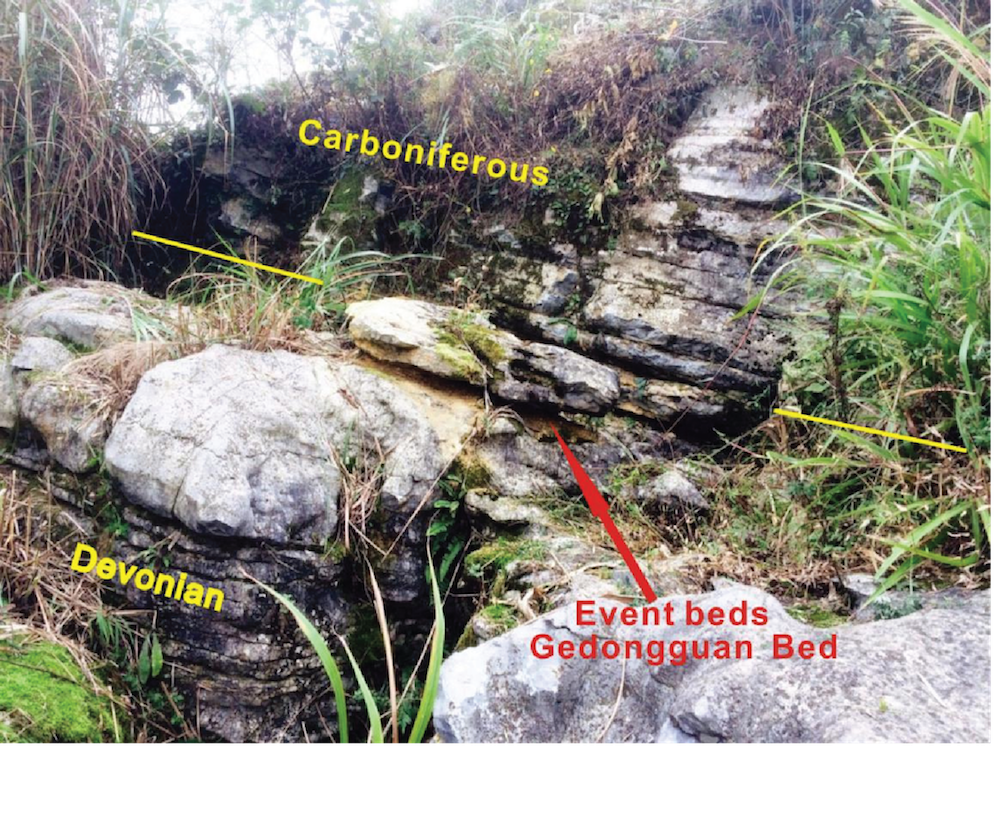Gedongguan Bed Fm
Type Locality and Naming
The type section is located in the top of Gedongguan Hill at east of Gedongguan Village, Muhua of Changshun County, Guizhou Province (25°48′16.71′′N, 06°24′21.9′′E). It was named by Hou et al. in 1985 based on the Muhua II roadside section.
Lithology and Thickness
Claystone and volcanic ash. In the type section it is composed of three beds from base to top: (i) Changshun black shale, with millimetric to centimetric thick; (ii) light yellow, soft, earthy-like bentonite mainly characterized by illite with quartz, feldspar, apatite, zircon, etc., millimeters to few centimeters thick, (the maximum thickness is ca. 4.5 cm); (iii) yellow to light gray mudstone to marlstone with lenses of clayey limestone. 2 - 4.5 cm thick.
[Figure Outcrops showing the Gedongguan Bed in type locality of Daposhang section (upper) and the tuff bed in Muhua roadside section (lower). 28 cm long hammer and 1.9 cm coin diameter as scale. Note the black remains below the tuff bed in Muhua roadside section may represent lost shale.]
Relationships and Distribution
Lower contact
The basal contact with the underlying Daihua Fm is sharp. It has a distinct upward lithological change from well-stratified micritic limestone to overlying black shale.
Upper contact
It is conformable and gradual contact with overlying basal-Carboniferous limestone (Wangyou Fm on chart), which contains the same conodont Protognathodus kockeli.
[Figure Outcrop showing the Devonian-Carboniferous boundary beds with the event deposit Gedongguan Bed in the Daposhang Hill of Muhua area.]
Regional extent
GeoJSON
Fossils
It yields spores in the black shale Punctatisporite spp., Retusotriletes communis, Apiculiretusispora sp., Verrucosisporites depressus, etc. Ammonoid Postclymenia cf. evoluta associated with bivalves Posidonia (now Guerichia), and productid brachiopods are reported in Jiarantang section of Xiasi, Dushan but poorly preserved. Conodont Protognathodus kockeli occurs in the limestone lenses within mudstone in type locality.
Age
Depositional setting
The Gedongguan Bed is interpreted as a upper slope facies and was deposited in a complex set of environments. The black shale has been reported as being in relatively offshore, deep water with relatively low to anoxic oxygen conditions.
Additional Information
The equivalent Bed has widely global distribution. In South China it is mainly developed in basin and slope facies and reported from Guangxi, Guizhou and southeastern Yunnan. The black shale is commonly seen in Xiasi, Dushan of Guizhou, where the thickness up to 1 m. A similar bed with black shale below and gray shale above was reported from Lali section of Hechi, Guangxi. It was observed in Huangmao section of Wuxuan, Guangxi as a black carbonaceous shale, 0.34 to 0.6 m thick, with sharp contact with its overlying and underlying limestones. A peak of nickel and iridium abundance is recorded in this level and was considered as a Ni-event, named the Hangenberg nickel episode (Bai et al., 1994). However, the volcanic tuff is only occurred in Muhua area. As to the upper contact in some places the Bed is directly overlain by limestone yielding conodont Siphonodella sulcata. The absence of conodont Protognathodus kockeli Zone may implies local non-deposition or erosion in the stratigraphic record. It is a very important unit in the topmost Devonian Daihua Formation for studying Devonian-Carboniferous boundary and mass extinction.

